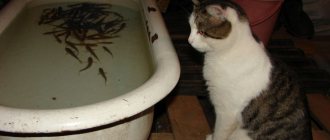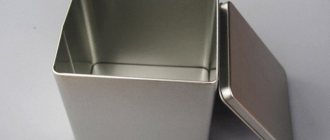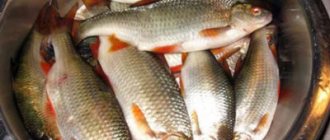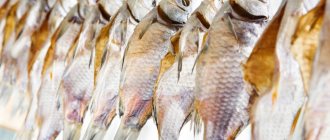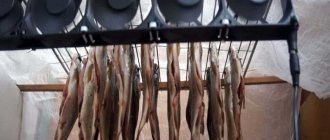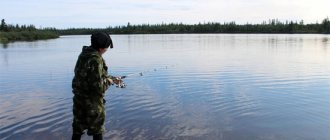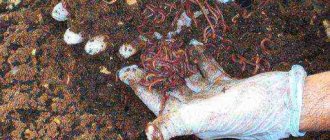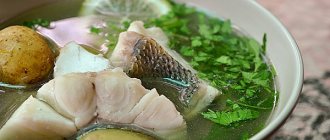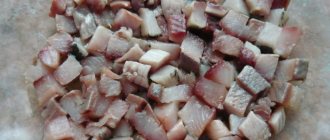3 382
- share
- share
- share
- share
- tweet
- share
In this article we will tell you how to preserve fish while fishing with a minimum of equipment and funds, and the complete absence of a refrigerator.
Throughout the history of fishing, cunning people have developed a lot of techniques that help delay the moment of fish spoilage as much as possible, or even eliminate it altogether. However, before moving on to their description, it would be useful to clarify - what causes fish to spoil in general? And what processes take place in it?
Cold storage
At the beginning of the story, let's talk a little about how to properly store caught fish in the refrigerator. An indispensable condition for this is the delivery of the catch home fresh, that is, we will not talk about products from the supermarket.
Without freezing, the catch can be kept in the refrigerator for no more than four hours. And then only on condition that the fish brought from the reservoir was fresh.
In the freezer, the shelf life can be quite long. But even if you avoid defrosting, you shouldn’t keep fish there for more than eight months.
There is a lot of debate about whether to clean fresh fish before freezing. The author of the article recommends freezing it entirely. This way the products retain all the juices and nutrients. When cooked, cleaned carcasses become less fatty and almost tasteless.
The only exception is trophy pike. Its author cuts it into several parts, because the whole fish does not fit into the freezer lengthwise. But even in this case, only the insides are cleaned, the skin remains intact.
A three-kilogram pike has a length of about 70-80 centimeters.
How to preserve fish for a long time
If you are thinking about how to preserve fish even longer, you can use a more complex method. First you need to gut the fish, remove all the entrails and gills. You need to be especially careful when removing the gallbladder, trying not to damage it, otherwise spilled bile can spoil the taste of the fish. Then sprinkle the head, spine and internal cavity of the fish generously with coarse salt. The outside of the fish must also be salted by rubbing salt against the scales. After this, put nettle or wheatgrass leaves into the abdominal cavity of the fish and put them in a basket, also adding nettles or wheatgrass.
You can also pickle ungutted fish. In this case, it should be washed well, placed in a salt solution and pressed with pressure. After some time, remove the fish from the brine and hang it in the air to let it dry. The time the fish spends in the brine is determined by its size and the shelf life of the fish; the larger the fish and the longer you want to keep it, the longer it should be in the brine.
In order to salt fish in large quantities, it is best to use small barrels. Previously, oak barrels were used for this purpose, but now this is quite problematic, so it is quite possible to get by with modern food containers. These can be either barrels or plastic buckets with hermetically sealed lids, the main thing is that these containers do not react with the saline solution. Before salting, the fish must be gutted, gills removed and scales removed. Then wipe each carcass dry (do not wash the fish) and rub with coarse salt. The prepared carcasses are placed tightly in a container and the lid is tightly closed. After some time, the fish will “give juice” and will be in a natural brine. To better wet the entire fish with brine, the container should be turned over from time to time. Fish salted in this way can be stored for up to six months.
In order to dry fish, it must first be salted. This is done as follows: small fish are not gutted, but simply sprinkled with coarse salt, placed in several layers in glass, porcelain or enamel dishes, covered with a lid or simply an inverted plate. Place pressure on the lid and leave for several hours. After the fish is salted, it is dried with a napkin and hung in a dry, shaded, preferably well-ventilated place. To protect against insects at first, you can cover the fish with gauze. It is better to hang the fish by the tail. To do this, you can use paper clips or wire hooks. Fish hung for drying should not touch each other. The fish takes quite a long time to dry. The drier the dried fish is, the longer it can last. Large fish are prepared differently for salting; they must be gutted and rubbed with salt from the inside, and when hanging for drying, spacers made of wooden sticks must be inserted into the belly. If the fish is very large, then you can dry it not as whole carcasses, but as fillet plates.
There are two ways to smoke fish: hot and cold. The fundamental difference is the smoke temperature and smoking time. Cold smoked fish is stored much longer than hot smoked fish.
During hot smoking, the smoke temperature is very high, the fish is practically above the smoldering sawdust. With this method, the fish is partially baked and partially smoked. The consistency of the finished product is quite loose. Hot smoking time ranges from 30 minutes to 1.5 hours, depending on the size of the fish and the design of the smokehouse.
With cold smoking, the smoke temperature is much lower, approximately +40 degrees, but the smoke density should be very high. Cold smoking time can be 3 - 7 days. During this process, the fish is partially dried and partially smoked. The consistency of the finished product is more elastic and dry.
Live fish
It is best to store live fish brought from a reservoir in a large container with fresh water. If you have your own well, great, city water supply will not work, there may be undesirable substances there, such as bleach, for example.
Attention! You need to change the water often, especially in the summer. It is also recommended to use an aquarium type air compressor.
Crucian carp are best stored fresh. From the container, some go to food, others go to the reservoir as live bait for catching pike.
How to keep fish in a cage
When fishing with a float rod or feeder, all care for the caught fish, if there are no injuries, can be entrusted to a stationary mesh cage , which will not hamper the movement of the fish. Less preferable is a wire cage, in which the survival rate of fish is much lower - such cages, by definition, are not spacious, and the fish in them are seriously injured.
To prevent the fish tank from becoming a mass grave for the fish, it should be placed in a quiet, shady place, at least a meter deep, but in no case near the surf shore. Here, due to the constant movement of water in the bottom layers, the gills of the caught fish become clogged with silt and sand, and it quickly falls asleep.
Especially large specimens should be kept separate from the rest of the catch. It is preferable to use a separate kukan for each giant. Because of its sharp teeth, the pike is always kept only on a hook with a metal clasp, and never in a fabric cage, from which it will quickly arrange an escape for itself and other captives.
If a fish in a cage floats up belly up , it must be urgently removed and euthanized by stunning it with a blow to the area of the head behind the eyes with a heavy object. Dormant fish in water will deteriorate even faster than in the sun, so you need to act decisively.
Fishing
Next we will talk about how to preserve fish while fishing. Let's consider all cases concerning caught fish.
Zadok
The best way to preserve the catch of peaceful fish is a cage. In this case, you need to comply with some important requirements:
- the cage must be spacious enough;
- It is advisable to use mesh structures; wire trophies are often injured;
- it must be lowered to a depth of at least one meter, otherwise the fish may suffocate;
- It is desirable that at the location of the cage there is a shadow from the coastal environment: cliff, stone, trees;
- It should be placed near the surf shore so that silt or sand is not drawn into the cage, which can quickly clog the gills of your trophies.
A large cage is a guarantee of preserving the catch.
Important! The catch should be checked from time to time. If you find a fish floating up with its belly, remove it. After euthanasia, the trophy should be placed in a separate container.
Kukan
Kukan will also help preserve fish in the heat. It should be used for predators and large specimens of leucorrhoea. Most often, pike, large perch, chub, and carp are planted on kukan.
When using this device, you also need to follow certain conservation recommendations:
- if fishing takes place in one place, the kukan should be located conveniently at hand;
- when fishing on the go, it is advisable to have several kukans and place them as you move along the shore, rather than dragging one along with you;
- It is better to thread the wire not under the gill cover, but through a special puncture in the jaw.
Properly placing the fish on the kukan will prevent it from premature death.
Dry storage
During long-term fishing, anything can happen, you can injure the fish while fishing, it can fall asleep in the cage or on the kukan. To prevent it from spoiling in hot weather, it is advisable to place the catch in a cooler bag.
Such refrigerators can be powered by a car battery, or they can be an insulated container. Cooling of food is carried out by placing ice from the home freezer inside the container.
An insulated bag is made from scrap materials. To store fish, crushed ice is placed in it.
Before storing fish, it should be ensured that it is euthanized. To do this, you need to make a targeted blow to the back of the head with a strong stick. Each carcass should also be wrapped in a separate towel or dry cloth.
There is a folk way to preserve fish without refrigeration. For this, grass growing along the banks of the reservoir is used. According to reviews from experienced fishermen, common nettle is best suited for this. We place the catch in a willow basket or hole dug in a damp place on the shore.
The procedure is as follows:
- We clean the fish, remove the gills, first of all, and the entrails. In this case, the carcasses do not need to be washed and scales removed from them either!
- Line the bottom of a basket or hole with nettle leaves.
- We place the cleaned fish on them so that the carcasses do not touch each other. We also put nettles inside the bellies.
- Cover the top with leaves, then place the fish again.
Attention! Fish in a basket with nettles can not only be stored for a long time, but also transported home.
If there is no basket, the nettle catch can be placed in a regular plastic bag.
Drying
Review of recipes for salting red fish
When fishing in the summer, a preservation method such as drying is also used. The natural mucus covering the fish body helps ensure the freshness of the product.
Under the influence of sunlight, the mucus dries and turns into a dense shell, preventing harmful bacteria from penetrating into the carcass. If the fish is left in the water, then the protective cover does not form, which leads to rapid spoilage of the product.
To prevent fish from spoiling during drying, you need to take the following measures:
- Cut off the gills of the fish.
- Remove the entrails, it is advisable to do this without opening the abdomen, pulling out all excess through the mouth.
- Press the gill covers tightly, tying them with thread, fishing line or clasping them with an elastic band.
- Place the prepared carcasses in a sunny, dry place blown by a breeze.
- After some time, turn the fish over to the other side.
- Dry until all surfaces are no longer damp at all.
When drying, it is important to prevent the carcasses from touching each other.
Dried fish should be placed in a cool, shaded place and covered with gauze or a clean cloth to prevent insects from getting to it. It is advisable to put the finished product in a bag or backpack with spruce or pine spruce branches.
At home, the fish should be placed in cold water for a while. Just 3-7 minutes are enough for it to get wet and take on its original appearance.
Pickling
When going on particularly long fishing trips, the methods listed above will not work; the fish will have to be subjected to additional processing. One popular method is salting.
If you do not have a refrigerator or a cool stream to store salted fish, it is advisable to gut it first. Then we do this:
- Spread a clean cloth at the bottom of the container and pour a layer of salt.
- We lay out the fish carcasses so that there is as little free space as possible.
- Sprinkle each layer generously with salt.
- We put oppression on top, it will help displace excess air and allow unfavorable putrefactive processes to start.
Attention! It is best to use a container with a perforated bottom to drain excess moisture. A regular basket will also work for this.
Don’t be afraid to oversalt the fish; the carcass will not take on more salt than it needs.
Smoking
An even more labor-intensive way to preserve fish is to smoke it. In this case, first the fish should also be salted for at least six hours.
Smoking can be done hot or cold. The first is more short-term, sometimes four hours can be enough. Fish is smoked with cold smoke for up to three days.
We will not dwell on the design of smokehouses in detail; this is not the subject of today’s proceedings. Let us only note that to ensure a “tasty” smoke, it is best to use alder shavings or wood from fruit trees: apple, plum, pear, cherry.
Attention! You should absolutely not use conifers for smoking; the resin released from them will cause bitterness and spoil the product!
It is easy to place such a camp smokehouse for the hot method in the trunk of a car.
How to preserve fish if it has already fallen asleep
If the fish “fell asleep”, you can preserve it for up to 12 hours by salting its gills and slightly drying it. To do this, the prepared fish is hung in a shaded, ventilated place and covered with gauze to protect it from flies and other insects.
If the fish is large enough, it makes sense to first carefully gut it and remove the gills. The dried fish is covered with nettles, placed in a basket and put in the shade.
In cool weather (spring or autumn), the shelf life of fish is 1-2 days. Just hang it in a dry, ventilated place. If you remove the gills from the fish and gut it, the shelf life of the fish can increase to 4 days.
To preserve fish for 3 days, you can use the simplest natural preservatives: salt, sugar, vinegar. It is necessary to dissolve 1 - 2 heaped teaspoons of sugar in half a liter of 9% vinegar, soak a cloth napkin with this solution and wrap it around the fish, previously sprinkled with salt.
Live bait delivery
Sometimes you need to deliver fish not home from fishing, but, on the contrary, to a reservoir. We mean transporting live bait to catch a predator. Both in winter and in summer, a special container is best suited for this - kan.
Industrial can is made from EVA material - ethylene vinyl acetate.
In summer
At any time of the year, the task of the kana is to isolate the water inside from the influence of the external environment. In summer it is necessary to prevent overheating, in winter hypothermia and freezing.
In the summer, several tricks are used to ensure the comfort of live bait fish:
- take with them a supply of water, which replaces the heating liquid in the kana;
- add ice from your home refrigerator;
- A compressor is used to supply oxygen: manual or electric.
in winter
On the one hand, it is easier to preserve live bait in winter; it will never die from overheating; on the other hand, in very severe frosts, additional insulation will be needed.
Winter tanks for live bait are most often made by fishermen at home. Glass or plastic containers are used as a base, which are subsequently covered with heat-insulating materials:
- polystyrene foam;
- foam;
- folgoizol.
Initial materials for the manufacture of fishing canals.
How to preserve fish - what to do with wounded fish
If the fish is injured in the process of fishing or being removed from the hook (deeply swallowed the bait and the hook damaged the internal organs or gills from which blood is oozing), neither the cage, nor the kukan, nor special resuscitation measures will help the fish. Such a specimen should be euthanized with a precise blow to the back of the head, wrapped in a dry towel and placed in a cool place away from direct sunlight. a large basket of grass (preferably nettle) has worked well ; there should be twice as much grass as fish. Carcasses should not touch each other. In both cases, relative coolness and ventilation are important. During transportation, carcasses must breathe, so the use of plastic bags is highly undesirable . If an angler comes to fish by car, it makes sense to use an insulated container with ice to preserve the catch.
How to preserve fish: in the heat of summer without freezing
If during winter fishing the question is “how to save fish?” disappears automatically, then in the summer it is, on the contrary, one of the most important in the entire fishing process. This is especially true in hot summer weather, when fish - if you don't take action - spoils very quickly, which is why you can easily lose your precious catch.
Let me make a reservation right away: I will not consider methods of preserving fish such as hot and cold smoking, because they:
- They require additional equipment for their implementation - a portable or stationary smokehouse.
- They refer not to methods of extending the shelf life of the catch, but to its final preparation.
In this article I will tell you exactly how to preserve fish while fishing with a minimum of equipment and funds, and the complete absence of a refrigerator.
Throughout the history of fishing, cunning people have developed a lot of techniques that help delay the moment of fish spoilage as much as possible, or even eliminate it altogether. However, before moving on to their description, it would be useful to clarify - what causes fish to spoil in general? And what processes take place in it?
